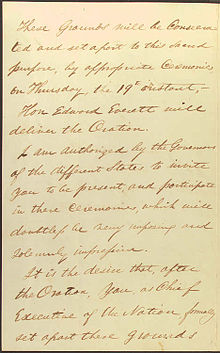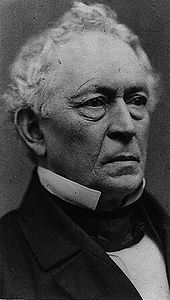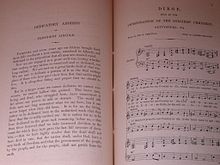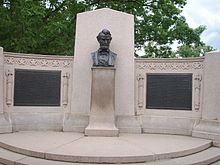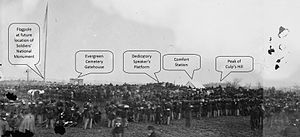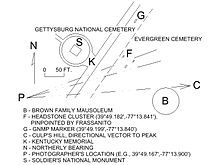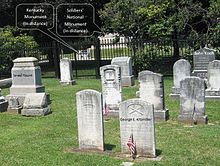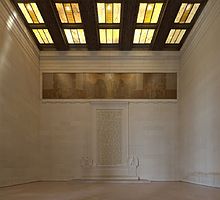
Gettysburg Address
Did you know...
SOS Children made this Wikipedia selection alongside other schools resources. SOS Child sponsorship is cool!
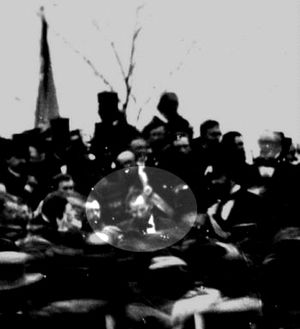
The Gettysburg Address is a speech by U.S. President Abraham Lincoln, one of the best-known in American history. It was delivered by Lincoln during the American Civil War, on the afternoon of Thursday, November 19, 1863, at the dedication of the Soldiers' National Cemetery in Gettysburg, Pennsylvania, four and a half months after the Union armies defeated those of the Confederacy at the Battle of Gettysburg.
Abraham Lincoln's carefully crafted address, secondary to other presentations that day, came to be regarded as one of the greatest speeches in American history. In just over two minutes, Lincoln reiterated the principles of human equality espoused by the Declaration of Independence and proclaimed the Civil War as a struggle for the preservation of the Union sundered by the secession crisis, with "a new birth of freedom," that would bring true equality to all of its citizens, ensuring that democracy would remain a viable form of government and creating a nation in which states' rights were no longer dominant. Lincoln also redefined the Civil War as a struggle not just for the Union, but also for the principle of human equality.
Beginning with the now-iconic phrase "Four score and seven years ago," referring to the Declaration of Independence, written at the start of the American Revolution in 1776, Lincoln examined the founding principles of the United States in the context of the Civil War, and memorialized the sacrifices of those who gave their lives at Gettysburg and extolled virtues for the listeners (and the nation) to ensure the survival of America's representative democracy, that "government of the people, by the people, for the people, shall not perish from the earth."
Despite the speech's prominent place in the history and popular culture of the United States, the exact wording and location of the speech are disputed. The five known manuscripts of the Gettysburg Address differ in a number of details and also differ from contemporary newspaper reprints of the speech. Modern scholarship locates the speakers' platform 40 yards (or more) away from the Traditional Site within Soldiers' National Cemetery at the Soldiers' National Monument and entirely within private, adjacent Evergreen Cemetery.
Background
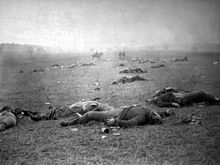
Following the July 1–3, 1863, Battle of Gettysburg, reburial of Union soldiers from the Gettysburg Battlefield graves began on October 17. The committee for the November 19 Consecration of the National Cemetery at Gettysburg invited President Lincoln: "It is the desire that, after the Oration, you, as Chief Executive of the nation, formally set apart these grounds to their sacred use by a few appropriate remarks." Lincoln's address followed the oration by Edward Everett, who subsequently included a copy of the Gettysburg Address in his 1864 book about the event (Address of the Hon. Edward Everett At the Consecration of the National Cemetery At Gettysburg, 19th November 1863, with the Dedicatory Speech of President Lincoln, and the Other Exercises of the Occasion; Accompanied by An Account of the Origin of the Undertaking and of the Arrangement of the Cemetery Grounds, and by a Map of the Battle-field and a Plan of the Cemetery).
During the train trip from Washington, D.C., to Gettysburg on November 18, Lincoln remarked to John Hay that he felt weak. On the morning of November 19, Lincoln mentioned to John Nicolay that he was dizzy. In the railroad car the President rode with his secretary, John G. Nicolay, his assistant secretary, John Hay, the three members of his Cabinet who accompanied him, William Seward, John Usher and Montgomery Blair, several foreign officials and others. Hay noted that during the speech Lincoln's face had 'a ghastly colour' and that he was 'sad, mournful, almost haggard.' After the speech, when Lincoln boarded the 6:30pm train for Washington, D.C., he was feverish and weak, with a severe headache. A protracted illness followed, which included a vesicular rash and was diagnosed as a mild case of smallpox. It thus seems highly likely that Lincoln was in the prodromal period of smallpox when he delivered the Gettysburg address.
Program and Everett's "Gettysburg Oration"
The program organized for that day by Wills and his committee included:
- Music, by Birgfield's Band
- Prayer, by Reverend T.H. Stockton, D.D.
- Music, by the Marine Band
- Oration, by Hon. Edward Everett
- Music, Hymn composed by B.B. French, Esq.
- Dedicatory Remarks, by the President of the United States
- Dirge, sung by Choir selected for the occasion
- Benediction, by Reverend H.L. Baugher, D.D.
While it is Lincoln's short speech that has gone down in history as one of the finest examples of English public oratory, it was Everett's two-hour oration that was slated to be the "Gettysburg address" that day. His now seldom-read 13,607-word oration began:
- "Standing beneath this serene sky, overlooking these broad fields now reposing from the labors of the waning year, the mighty Alleghenies dimly towering before us, the graves of our brethren beneath our feet, it is with hesitation that I raise my poor voice to break the eloquent silence of God and Nature. But the duty to which you have called me must be performed; — grant me, I pray you, your indulgence and your sympathy."
And ended two hours later with:
- "But they, I am sure, will join us in saying, as we bid farewell to the dust of these martyr-heroes, that wheresoever throughout the civilized world the accounts of this great warfare are read, and down to the latest period of recorded time, in the glorious annals of our common country, there will be no brighter page than that which relates the Battles of Gettysburg."
Text of Gettysburg Address
Shortly after Everett's well-received remarks, Lincoln spoke for only a few minutes. With a "few appropriate remarks", he was able to summarize the war in just ten sentences.
Despite the historical significance of Lincoln's speech, modern scholars disagree as to its exact wording, and contemporary transcriptions published in newspaper accounts of the event and even handwritten copies by Lincoln himself differ in their wording, punctuation, and structure. Of these versions, the Bliss version, written well after the speech as a favour for a friend, is viewed by many as the standard text. Its text differs, however, from the written versions prepared by Lincoln before and after his speech. It is the only version to which Lincoln affixed his signature, and the last he is known to have written.
Four score and seven years ago our fathers brought forth on this continent a new nation, conceived in liberty, and dedicated to the proposition that all men are created equal.Now we are engaged in a great civil war, testing whether that nation, or any nation so conceived and so dedicated, can long endure. We are met on a great battle field of that war. We have come to dedicate a portion of that field, as a final resting place for those who here gave their lives that that nation might live. It is altogether fitting and proper that we should do this.
But, in a larger sense, we can not dedicate, we can not consecrate, we can not hallow this ground. The brave men, living and dead, who struggled here, have consecrated it, far above our poor power to add or detract. The world will little note, nor long remember what we say here, but it can never forget what they did here. It is for us the living, rather, to be dedicated here to the unfinished work which they who fought here have thus far so nobly advanced. It is rather for us to be here dedicated to the great task remaining before us—that from these honored dead we take increased devotion to that cause for which they gave the last full measure of devotion—that we here highly resolve that these dead shall not have died in vain—that this nation, under God, shall have a new birth of freedom—and that government of the people, by the people, for the people, shall not perish from the earth.
 |
Gettysburg Address
A modern recording of Lincoln's Gettysburg Address.
|
| Problems listening to this file? See media help. | |
Five manuscripts
The five known manuscript copies of the Gettysburg Address are each named for the associated person who received it from Lincoln. Lincoln gave a copy to each of his private secretaries, John Nicolay and John Hay. Both of these drafts were written around the time of his November 19 address, while the other three copies of the address, the Everett, Bancroft, and Bliss copies, were written by Lincoln for charitable purposes well after November 19. In part because Lincoln provided a title and signed and dated the Bliss copy, it has become the standard text of Lincoln's Gettysburg Address.
Nicolay and Hay were appointed custodians of Lincoln's papers by Lincoln's son Robert Todd Lincoln in 1874. After appearing in facsimile in an article written by John Nicolay in 1894, the Nicolay copy was presumably among the papers passed to Hay by Nicolay's daughter Helen upon Nicolay's death in 1901. Robert Lincoln began a search for the original copy in 1908, which resulted in the discovery of a handwritten copy of the Gettysburg Address among the bound papers of John Hay—a copy now known as the "Hay copy" or "Hay draft."
The Hay draft differed from the version of the Gettysburg Address published by John Nicolay in 1894 in a number of significant ways: it was written on a different type of paper, had a different number of words per line and number of lines, and contained editorial revisions in Lincoln's hand.
Both the Hay and Nicolay copies of the Address are within the Library of Congress, encased in specially designed, temperature-controlled, sealed containers with argon gas in order to protect the documents from oxidation and continued deterioration.
Nicolay copy
The Nicolay copy is often called the "first draft" because it is believed to be the earliest copy that exists. Scholars disagree over whether the Nicolay copy was actually the reading copy Lincoln held at Gettysburg on November 19. In an 1894 article that included a facsimile of this copy, Nicolay, who had become the custodian of Lincoln's papers, wrote that Lincoln had brought to Gettysburg the first part of the speech written in ink on Executive Mansion stationery, and that he had written the second page in pencil on lined paper before the dedication on November 19. Matching folds are still evident on the two pages, suggesting it could be the copy that eyewitnesses say Lincoln took from his coat pocket and read at the ceremony. Others believe that the delivery text has been lost, because some of the words and phrases of the Nicolay copy do not match contemporary transcriptions of Lincoln's original speech. The words "under God", for example, are missing in this copy from the phrase "that this nation shall have a new birth of freedom..." In order for the Nicolay draft to have been the reading copy, either the contemporary transcriptions were inaccurate, or Lincoln would have had to depart from his written text in several instances. This copy of the Gettysburg Address apparently remained in John Nicolay's possession until his death in 1901, when it passed to his friend and colleague John Hay. It used to be on display as part of the American Treasures exhibition of the Library of Congress in Washington, D.C.
Hay copy
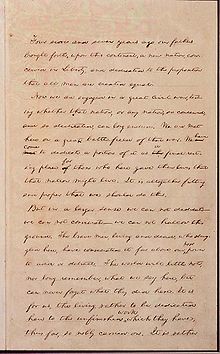
The existence of the Hay copy was first announced to the public in 1906, after the search for the "original manuscript" of the Address among the papers of John Hay brought it to light. Significantly, it differs somewhat from the manuscript of the Address described by John Hay in his article, and contains numerous omissions and inserts in Lincoln's own hand, including omissions critical to the basic meaning of the sentence, not simply words that would be added by Lincoln to strengthen or clarify their meaning. In this copy, as in the Nicolay copy, the words "under God" are not present.
This version has been described as "the most inexplicable" of the drafts and is sometimes referred to as the "second draft." The "Hay copy" was made either on the morning of the delivery of the Address, or shortly after Lincoln's return to Washington. Those who believe that it was completed on the morning of his address point to the fact that it contains certain phrases that are not in the first draft but are in the reports of the address as delivered and in subsequent copies made by Lincoln. It is probable, they conclude, that, as stated in the explanatory note accompanying the original copies of the first and second drafts in the Library of Congress, Lincoln held this second draft when he delivered the address. Lincoln eventually gave this copy to his other personal secretary, John Hay, whose descendants donated both it and the Nicolay copy to the Library of Congress in 1916.
Everett copy
The Everett copy, also known as the "Everett-Keyes copy," was sent by President Lincoln to Edward Everett in early 1864, at Everett's request. Everett was collecting the speeches at the Gettysburg dedication into one bound volume to sell for the benefit of stricken soldiers at New York's Sanitary Commission Fair. The draft Lincoln sent became the third autograph copy, and is now in the possession of the Illinois State Historical Library in Springfield, Illinois, where it is currently on display in the Treasures Gallery of the Abraham Lincoln Presidential Library and Museum.
Bancroft copy
The Bancroft copy of the Gettysburg Address was written out by President Lincoln in February 1864 at the request of George Bancroft, the famed historian and former Secretary of the Navy whose comprehensive ten volume History of the United States, later led him to be known as the "father of American History." Bancroft planned to include this copy in Autograph Leaves of Our Country's Authors, which he planned to sell at a Soldiers' and Sailors' Sanitary Fair in Baltimore. As this fourth copy was written on both sides of the paper, it proved unusable for this purpose, and Bancroft was allowed to keep it. This manuscript is the only one accompanied both by a letter from Lincoln transmitting the manuscript and by the original envelope addressed and franked by Lincoln. This copy remained in the Bancroft family for many years, was sold to various dealers and purchased by Nicholas and Marguerite Lilly Noyes, who donated the manuscript to Cornell in 1949. It is now held by the Division of Rare and Manuscript Collections in the Carl A. Kroch Library at Cornell University. It is the only one of the five copies to be privately owned.
Bliss copy
Discovering that his fourth written copy could not be used, Lincoln then wrote a fifth draft, which was accepted for the purpose requested. The Bliss copy, named for Colonel Alexander Bliss, Bancroft's stepson and publisher of Autograph Leaves, is the only draft to which Lincoln affixed his signature. Lincoln is not known to have made any further copies of the Gettysburg Address. Because of the apparent care in its preparation, and in part because Lincoln provided a title and signed and dated this copy, it has become the standard version of the address and the source for most facsimile reproductions of Lincoln's Gettysburg Address. It is the version that is inscribed on the South wall of the Lincoln Memorial.
This draft is now displayed in the Lincoln Room of the White House, a gift of Oscar B. Cintas, former Cuban Ambassador to the United States. Cintas, a wealthy collector of art and manuscripts, purchased the Bliss copy at a public auction in 1949 for $54,000 ($521,000 as of 2013), at that time the highest price ever paid for a document at public auction. Cintas' properties were claimed by the Castro government after the Cuban Revolution in 1959, but Cintas, who died in 1957, willed the Gettysburg Address to the American people, provided it would be kept at the White House, where it was transferred in 1959.
Garry Wills concluded the Bliss copy "is stylistically preferable to others in one significant way: Lincoln removed 'here' from 'that cause for which they (here) gave...' The seventh 'here' is in all other versions of the speech." Wills noted the fact that Lincoln "was still making such improvements," suggesting Lincoln was more concerned with a perfected text than with an 'original' one.
From November 21, 2008 to January 1, 2009, the Albert H. Small Documents Gallery at the Smithsonian Institution National Museum of American History hosted a limited public viewing of the Bliss copy, with the support of Mrs. Laura Bush. The Museum also launched an online exhibition and interactive gallery to enable visitors to look more closely at the document.
Others
Another contemporary source of the text is the Associated Press dispatch, transcribed from the shorthand notes taken by reporter Joseph L. Gilbert. It also differs from the drafted text in a number of minor ways.
Location
Outside the Cemetery and within sight of the cross-walk, a historical marker proclaims:
- "Nearby, Nov. 19, 1863, in dedicating the National Cemetery, Abraham Lincoln gave the address which he had written in Washington and revised after his arrival at Gettysburg the evening of November 18."
Directly inside the Taneytown Road entrance are located the Rostrum and the Lincoln Address Memorial. Neither of these is located within 300 yards of any of the five (or more) claimed locations for the dedicatory platform.
Pre-modern
Colonel W. Yates Selleck was a marshall in the parade on Consecration Day and was seated on the platform when Lincoln made the address. Selleck marked a map with the position of the platform and described it as "350 feet almost due north of Soldiers' National Monument, 40 feet from a point in the outer circle of lots where [the] Michigan and New York [burial sections] are separated by a path." A location which approximates this description is 39°49.243'N,77°13.869'W.
As pointed out in 1973 by retired park historian Frederick Tilberg, the Selleck Site is 25 feet lower than the crest of Cemetery Hill, and only the crest presents a panoramic view of the battlefield. A spectacular view from the location of the speech was noted by many eyewitnesses, is consistent with the Traditional Site at the Soldiers' National Monument (and other sites on the crest) but is inconsistent with the Selleck Site.
The Kentucky Memorial was erected in 1975, is located directly adjacent to the Soldiers' National Monument, and states, "Kentucky honors her son, Abraham Lincoln, who delivered his immortal address at the site now marked by the soldiers' monument." With its position at the centre of the concentric rings of soldiers' graves and the continuing endorsement of Lincoln's native state the Soldiers' National Monument persists as a credible location for the speech.
Writing a physical description of the layout for the Gettysburg National Cemetery under construction in November 1863, the correspondent from the Cincinnati Daily Commercial described the dividing lines between the state grave plots as "the radii of a common centre, where a flag pole is now raised, but where it is proposed to erect a national monument." With the inclusion of this quotation Tilberg inadvertently verifies a central principle of future photographic analyses - a flagpole, rather than the speakers' platform, occupied the central point of the soldiers' graves. In fact, the precision of the photo-analyses relies upon the coincidence of position between this temporary flag pole and the future monument.
Confusing to today's tourist, the Kentucky Memorial is contradicted by a newer marker which was erected nearby by the Gettysburg National Military Park and locates the speakers' platform inside Evergreen Cemetery. Similarly, outdated National Park Service documents which pinpoint the location at the Soldiers' National Monument have not been systematically revised since the placement of the newer marker. Miscellaneous web pages perpetuate the Traditional Site.
Photo analyses
Based upon photographic analysis, the Gettysburg National Military Park (G.N.M.P.) placed a marker (near 39°49.199'N,77°13.840'W) which states, "The speakers' platform was located in Evergreen Cemetery to your left." The observer of this marker stands facing the fence which separates the two cemeteries (one public and one private).
In 1982, Senior Park Historian Kathleen Georg Harrison first analyzed photographs and proposed a location in Evergreen Cemetery but has not published her analysis. Garry Wills interprets the Harrison analysis to refer to a location "on or near [the] Brown family vault" in Evergreen Cemetery.
William A. Frassanito, a former military intelligence analyst, documented a comprehensive photographic analysis in 1995, and it associates the location of the platform with the position of specific modern headstones in Evergreen Cemetery. According to Frassanito, the extant graves of Israel Yount (d. 1892)(39°49.180,-77°13.845), John Koch (d. 1913)(39°49.184',-77°13.847'), and George E. Kitzmiller (d. 1874)(39°49.182',-77°13.841') are among those which occupy the location of the 1863 speaker's stand.
Resolution
The GNMP marker, Wills' interpretation of Harrison's analysis, and the Frassanito analysis concur that the platform was located in private Evergreen Cemetery, rather than public Soldiers' National Cemetery. The National Park Service's National Cemetery Walking Tour brochure is one NPS document which agrees:
- The Soldiers' National Monument, long misidentified as the spot from which Lincoln spoke, honours the fallen soldiers. [The location of the speech] was actually on the crown of this hill, a short distance on the other side of the iron fence and inside the Evergreen Cemetery, where President Lincoln delivered the Gettysburg Address to a crowd of some 15,000 people.
While the GNMP marker is unspecific, providing only "to your left," the locations determined by the Harrison/Wills analysis and the Frassanito analysis differ by 40 yards. Frassanito has documented 1) his own conclusion, 2) his own methods and 3) a refutation of the Harrison site, but neither the GNMP nor Harrison has provided any documentation. Each of the three points to a location in Evergreen Cemetery, as do modern NPS publications.
Although Lincoln dedicated the Gettysburg National Cemetery, the monument at the Cemetery's centre actually has nothing to do with Lincoln or his famous speech. Intended to symbolize Columbia paying tribute to her fallen sons, its appreciation has been commandeered by the thirst for a tidy home for the speech. Freeing the Cemetery and Monument to serve their original purpose, honoring of Union departed, is as unlikely as a resolution to the location controversy and the erection of a public monument to the speech in the exclusively private Evergreen Cemetery.
Legacy
The importance of the Gettysburg Address in the history of the United States is underscored by its enduring presence in American culture. In addition to its prominent place carved into a stone cella on the south wall of the Lincoln Memorial in Washington, D.C., the Gettysburg Address is frequently referred to in works of popular culture, with the implicit expectation that contemporary audiences will be familiar with Lincoln's words.
In the many generations that have passed since the Address, it has remained among the most famous speeches in American history, and is often taught in classes about history or civics. Lincoln's Gettysburg Address is itself referenced in another of those famed orations, Martin Luther King, Jr.'s " I Have a Dream" speech. Standing on the steps of the Lincoln Memorial in August 1963, King began with a reference, by the style of his opening phrase, to President Lincoln and his enduring words: "Five score years ago, a great American, in whose symbolic shadow we stand today, signed the Emancipation Proclamation. This momentous decree came as a great beacon light of hope to millions of Negro slaves who had been seared in the flames of withering injustice."
Phrases from the Address are often used or referenced in other works. The current Constitution of France states that the principle of the Republic of France is "gouvernement du peuple, par le peuple et pour le peuple" ("government of the people, by the people, and for the people,") a literal translation of Lincoln's words. Sun Yat-Sen's " Three Principles of the People" were inspired from that phrase as well. The aircraft carrier USS Abraham Lincoln has as its ship's motto the phrase "shall not perish".
U.S. Senator Charles Sumner of Massachusetts wrote of the address and its enduring presence in American culture after Lincoln's assassination in April 1865: "That speech, uttered at the field of Gettysburg ... and now sanctified by the martyrdom of its author, is a monumental act. In the modesty of his nature he said 'the world will little note, nor long remember what we say here; but it can never forget what they did here.' He was mistaken. The world at once noted what he said, and will never cease to remember it."
